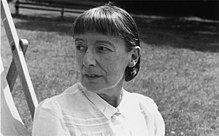Stevie Smith
Florence Margaret Smith , called Stevie Smith (born September 20, 1902 in Kingston upon Hull , † March 7, 1971 in London ), was an English writer .
Life and work
She was the second daughter of Ethel and Charles Smith. At first she was called Peggy by relatives, but as a young woman she was given the nickname Stevie, as she looked like the then famous jockey Steve Donoghue while riding . The father left the family early to go to sea. From the age of three, Smith lived with her mother and sister with her aunt Madge in Palmers Green in the London Borough of Enfield . The mother died a few years later; Smith and her sister stayed with their aunt.
After finishing school, since 1923, she worked as a secretary at Newnes magazine publisher and eventually became the private secretary of the two managing directors. She was employed there until 1953. In the twenties she also began to write poetry, but did not emerge until 1936 with a novel as her first work. Her first volume of poetry was published a year later. Both publications established their status as difficult to classify poet. Over the years, two more novels with autobiographical features and eight volumes of poetry followed. In the 1960s she was known for the idiosyncratic public readings of her own works; she also read and sang her poems for radio and television. In 1969 she received the Queen's Gold Medal for Poetry .
Smith occupies a special position in English literature , as her poetry has little in common with that of her contemporaries. Sometimes influences from William Blake and Edward Lear can be seen. Smith's language oscillates between simplicity and archaism; she used both traditional and free forms. She decorated many poems with drawings, which underline the individuality of her lyrical works. The playful and humorous tone of many poems is reminiscent of nursery rhymes , but often contrasts with subtle melancholy and a thematic predilection for death and suicide.
Smith lived in Palmers Green until her death in 1971; she died of a brain tumor . She had cared for her aging Aunt Madge, even though she was in poor health herself. The aunt died in 1968 and Smith stayed in the house until the end of her own life just three years later. She was never married.
Works (selection)
- 1936: Novel on Yellow Paper
- 1937: A Good Time Was Had by All
- 1938: Over the Frontier
- 1938: Tender Only to One
- 1942: Mother, What Is Man?
- 1949: The Holiday
- 1950: Harold's Leap
- 1957: Not Waving but Drowning
- 1966: The Frog Prince and Other Poems
- 1969: The Best Beast
- 1972: Scorpion and Other Poems
literature
- Derk Frerichs: Author. Text and context in Stevie Smith's poetry in the 1930s. An investigation into the reality content, appearance and function of the author figure . Bochum / Freiburg i.Br .: Projektverlag 2000, ISBN 978-3-89733-053-5 .
- Ansgar Nünning : Smith, Stevie . In: Metzler Lexicon of English-Speaking Authors . 631 portraits - from the beginning to the present. Edited by Eberhard Kreutzer and Ansgar Nünning, Metzler, Stuttgart / Weimar 2002, p. 539f.
- Frances Spalding: Stevie Smith, a Critical Biography. London 1988.
- Sanford V. Sternlicht (Ed.): In Search of Stevie Smith. Syracuse 1991.
Web links
- Literature by and about Stevie Smith in the catalog of the German National Library
Individual evidence
- ↑ The Guardian's BooksBlog
- ↑ a b page on Smith at poetryarchive.org
- ^ Page on Smith at poetryfoundation.org
| personal data | |
|---|---|
| SURNAME | Smith, Stevie |
| ALTERNATIVE NAMES | Smith, Florence Margaret; Smith, Stevie |
| BRIEF DESCRIPTION | British poet and novelist |
| DATE OF BIRTH | September 20, 1902 |
| PLACE OF BIRTH | Kingston upon Hull |
| DATE OF DEATH | March 7, 1971 |
| Place of death | London |
